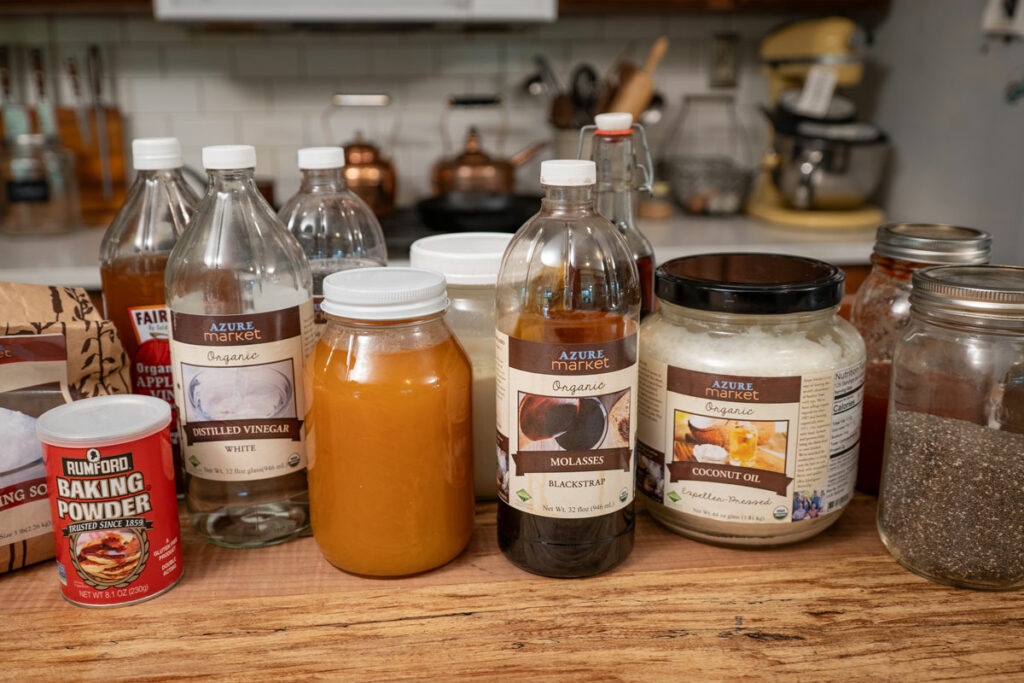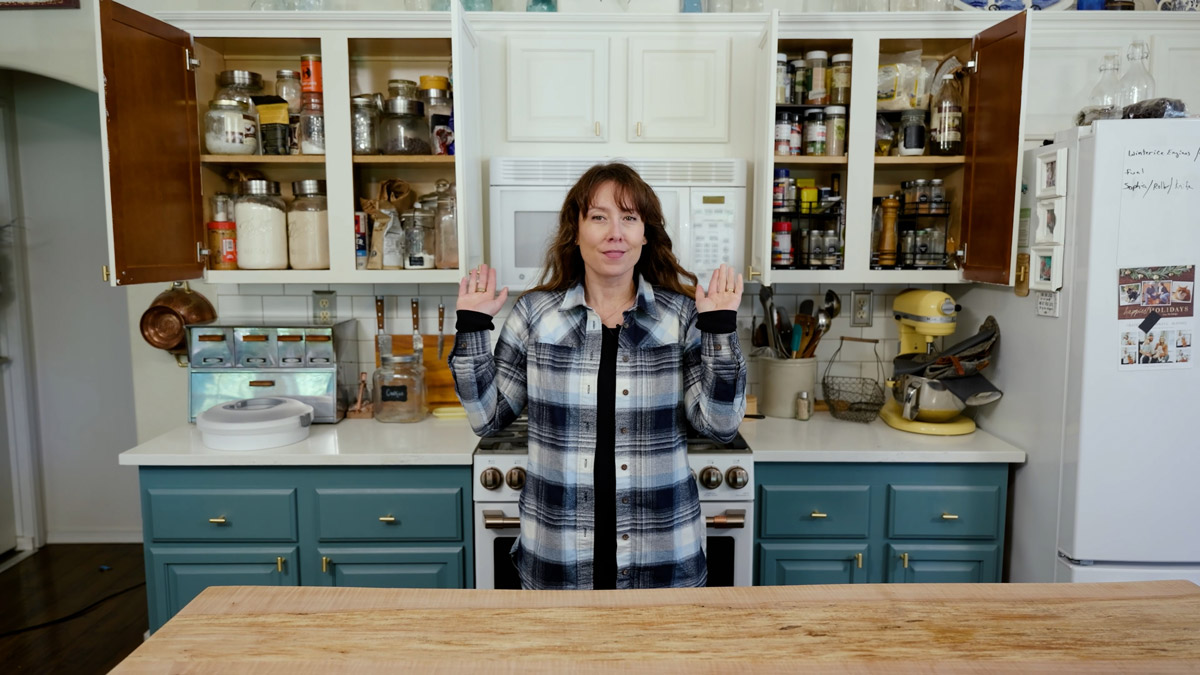Learn these tips for kitchen organization and building your homestead food storage and kitchen. Though no two kitchens will be alike, these tips can help you organize your kitchen so it works best for YOU!
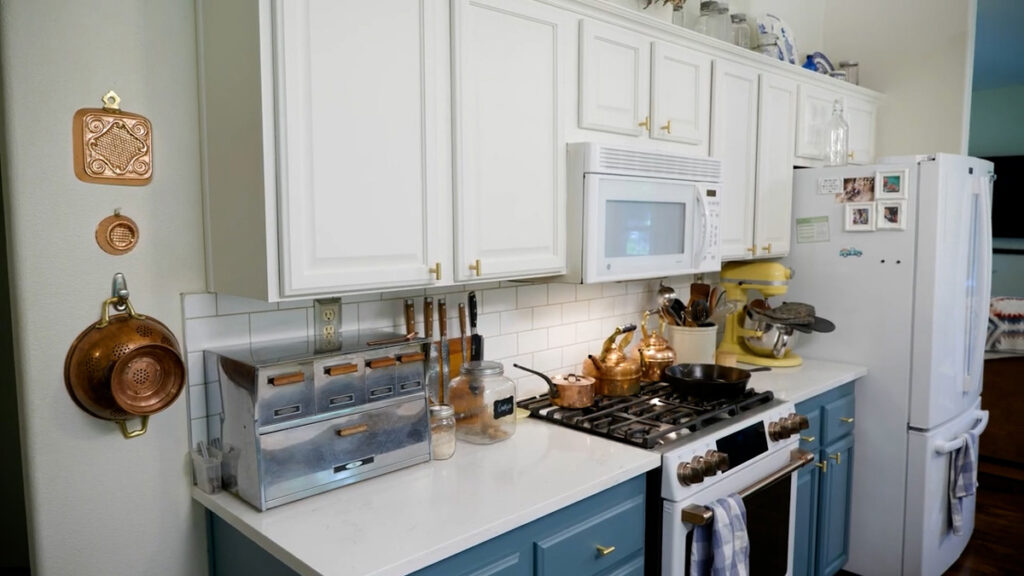
Let’s talk about organization, your kitchen, and food storage and how all of it ties together for a huge impact on your time management, budget, and health. Pretty big statement, I know, but oh so true.
🍞 Struggling With Sourdough?
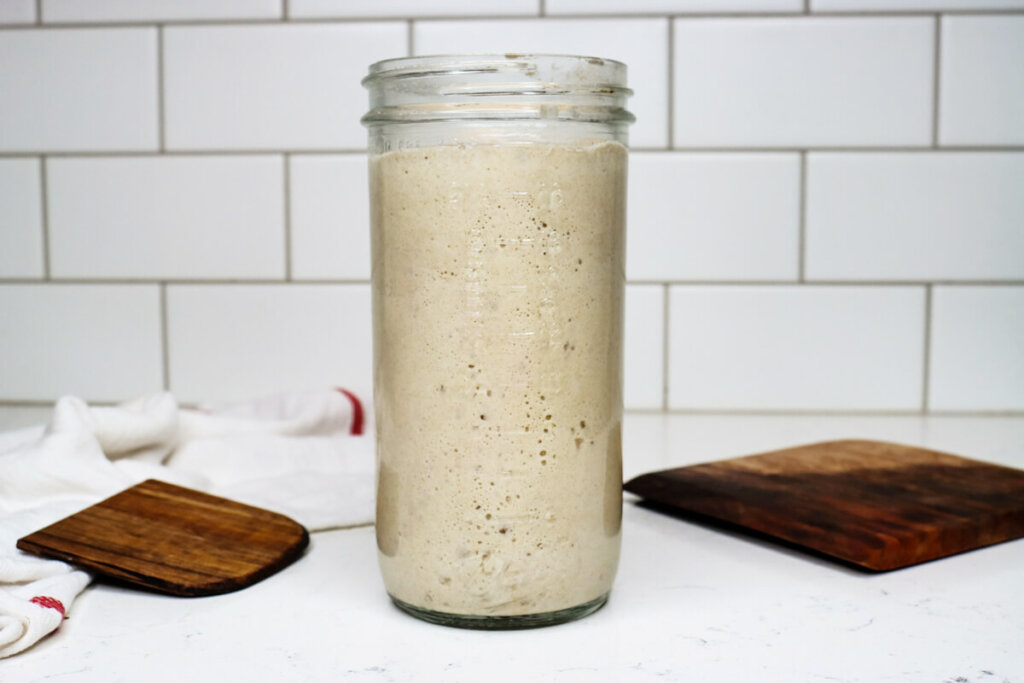
If your starter won’t take off, your loaves are dense and hard, or sourdough just flat-out overwhelms you…
👉 I’ll show you how to fix all of it.
Join my FREE live workshop and learn how to make a bubbly, active starter—the right way, from Day One.
🗓️ Jan 12 @ 1pm PT
I will be the first to tell you that I am not an organized person by nature. I know some of you were born with that gene, but it skipped over me. The good news is that we can overcome and get that way, even if it’s not our first inclination.
This post was originally published with episode #129 of the Pioneering Today Podcast but has since been updated with more tips and tricks and what I continue to learn about home organization over the years.
Organization & Food Storage
You may be wondering what organization and food storage have to do with one another… A lot, actually!
First off, how many times have you gone to the store and bought a can of coconut cream only to come home and realize you had two jars shoved way in the back, but you are totally out of shredded coconut? Apparently, I have a thing for coconuts. But you get my drift.
Not only did you waste your time, but now you either have to change recipes or go back to the store, which is more of a waste of money because, hello, extra gas funds and a waste of time. See this vicious cycle?
Or you knew you had a bag of almond flour and finally decided to try that new recipe, only to discover that on opening the bag, there’s only 1/4 cup left, and you need one full cup (and, of course, it’s after you’ve mixed all the rest of the ingredients together).
This all comes down to organization, my friend, or, in these cases, lack thereof.
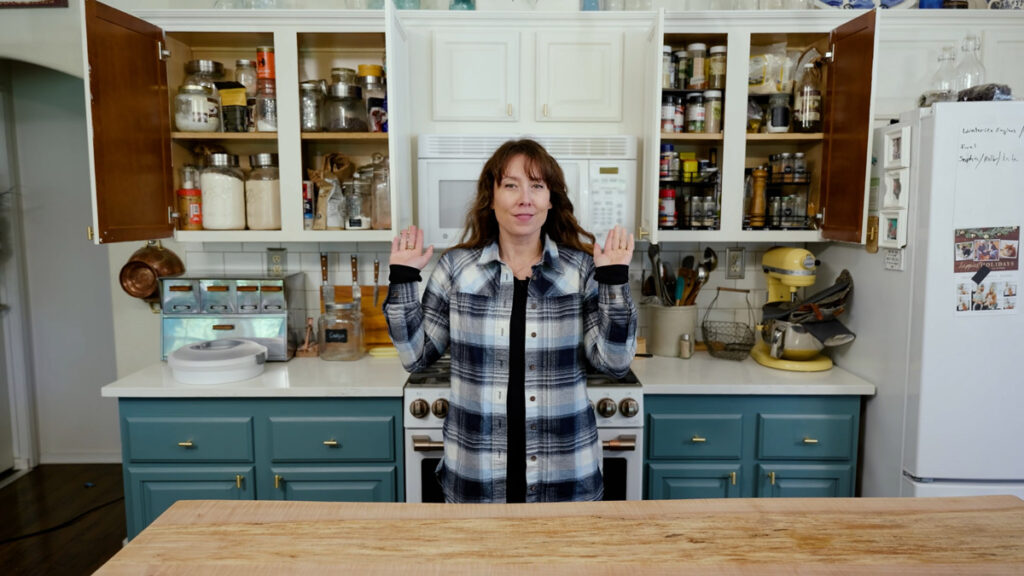
Organize & De-Clutter Once and For All
There are some things I’ve learned about “getting myself organized.” The goal is to declutter my home and keep it that way.
Stop wasting time rearranging your clutter. Tidying up the same old mess only to have to do the same thing again in a few weeks means you haven’t gotten to the root of your clutter problem, it just means you’re rearranging it.
Though there is some truth to this statement, it’s also true that, over the years, the systems I used to use to stay organized stopped working. This happens as we evolve and grow in our homemaking skills and become more efficient in our weekly tasks.
If you find your kitchen is getting cluttered and unorganized about once every week or two weeks, it’s likely that your setup isn’t working for you. The best time to reorganize your kitchen is when you’re doing a good deep cleaning.
So let’s get started!
- Everything Out – Take everything out of its spot. I mean, totally clear the entire cupboard and/or shelves and drawers. Everything comes out.
- Clean – Wipe down the space with a damp rag and some cleaner if need be. (Try my favorite homemade all-purpose cleaner recipe.)
- Evaluate – DO NOT put everything back (sorry for the yelling; it’s really to me, but this is key). Evaluate each and every item.
- Ask yourself how often it’s used (daily, weekly, at least once a month, etc.).
- Is there another item that does the same job? For example, I had a punch bowl and a pitcher. One does not need both; the punch bowl got donated, and the glass pitcher stayed.
- Is the item in the most logical spot? I needed my whisk, spatulas and spoons at the stove, but instead, they were all in a drawer that I had to walk around our island to reach. NOT convenient!
- Be ruthless as you declutter! I don’t mean throw everything you haven’t used in a month in the garbage, rather, ask yourself if it broke if you’d replace it.
- Everything Has a Home – The new rule is that everything you have left has to have a clear home and purpose. Don’t just put something back because “that’s where it’s always been.” Consider the flow and how you use your kitchen. If something would make more sense in a different spot, move it!
The secret to staying organized is everything has a place and you can quickly see when it’s not in it’s place and immediately take action.
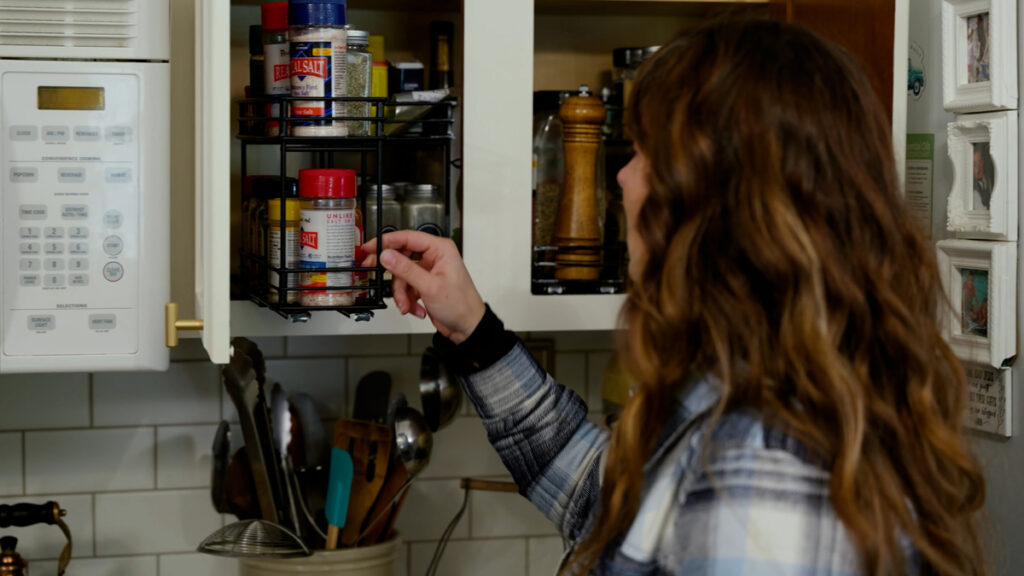
Organize Your Food Storage
Once you’ve organized your cooking supplies, appliances, and flow, it’s time to look at the food.
While we raise a lot of our own food and can upwards of 500 jars a year, I still purchase many things in bulk. I generally buy these from Azure Standard (items like chocolate chips, cocoa powder, coconut oil, shredded unsweetened coconut, almond meal, ground flax meal, baking powder, spices – you get the drift. (Note: If you’re a first-time Azure Standard customer, use code “Melissa15” at checkout to receive 15% off your first order of $100 or more!)
But here’s what I noticed about the food I purchased from the store and my home-canned stuff. When my food is in a clear container (aka Mason jars), I can tell at a quick glance exactly how much I have of each food.
When I leave it in the container from the store, I can’t tell if it’s almost empty unless I pick it up or open it. Plus, bags do not go into neat rows or stack easily like Mason jars or other glass food storage containers.
It’s way too easy to toss those bags into a cupboard or on a shelf, and pretty soon, I’m losing things in the back (and then repurchasing them when I don’t need to) or spending too much time rummaging through the piles to find what I want.
Resource Note: For growing your own food for food storage, see Episode #124, How to Plan Your Best Garden & Harvest for a Year’s Worth of Food.


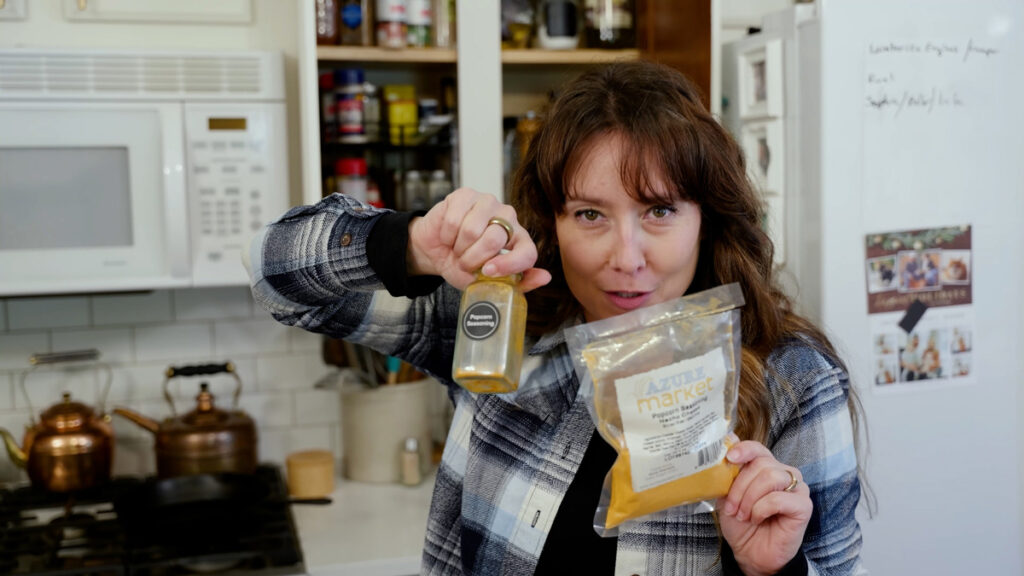
It’s also harder to practice proper rotation when things are a mess. First order of business:
- Combine all like food into a large clear container. Now you can easily see what you have at a glance. I use quart, half-gallon and gallon-sized Mason jars the most.
- Bulk items get stored in a smaller container in your main pantry or cooking area, then the rest goes in your long-term bulk-food storage location. I love these spice shelves from Amazon (they have multiple sizes)that allow me to stack two high, plus they pull out for easy access to the spices in the back! (They also fit a pint-sized Mason jar, which I use for spices I use frequently.) I also don’t know what I’d do without my salt cellar from Redmond!
- Keep like items together. This is twofold. I keep my baking items together in one cupboard: my flour (almond, small amount of organic all-purpose, ground golden flax), baking soda, baking powder, etc.
I have a bin of miscellaneous baking ingredients like unsweetened shredded coconut, my pie weights, which is a quart jar of dried beans, and a back of bags of organic semi-sweet chocolate chips (I have a 1/2 gallon Mason jar in my baking cupboard, but keep the backup stock in the bin). I have a large shelf of all my dehydrated foods and dry goods beneath my canning jars of home-canned foods, which hold pasta, buckwheat, nuts, seeds, dried tomatoes, peas, etc.
There you have it, the steps I use to organize our homestead kitchen and food storage and build it up. What are yours?
